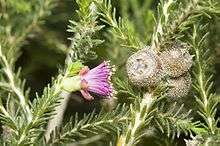Eremaea purpurea
Eremaea purpurea is a plant in the myrtle family, Myrtaceae and is endemic to the south-west of Western Australia. It is a shrub with erect branches, small leaves and purple flowers in pairs on the ends of the branches. The fruits are woody, cup-shaped capsules which release their seeds when dry.
| Eremaea purpurea | |
|---|---|
 | |
| Scientific classification | |
| Kingdom: | Plantae |
| Clade: | Tracheophytes |
| Clade: | Angiosperms |
| Clade: | Eudicots |
| Clade: | Rosids |
| Order: | Myrtales |
| Family: | Myrtaceae |
| Genus: | Eremaea |
| Species: | E. purpurea |
| Binomial name | |
| Eremaea purpurea C.A.Gardner[1] | |
| Synonyms | |
|
Melaleuca ostrina Craven & R.D.Edwards | |
Description
Eremaea purpurea is a shrub growing to a height of about 1.0 metre (3 ft). The branches point upwards and the young stems are densely covered with hair. The leaves are narrow egg-shaped, tapering to a point and are 2–4.5 millimetres (0.08–0.2 in) long, 2–2.5 millimetres (0.08–0.1 in) wide and sometimes have a single vein visible on the lower surface. There are a few long, soft hairs on the upper surface and edges of the leaves.[2]
The flowers are pink to deep pink and are borne usually in pairs on the ends of the branches. They have 5 sepals which are often hairy on the outside surface and 5 petals, 4.2–4.5 millimetres (0.17–0.18 in) long. The stamens, which give the flower its colour are arranged in 5 bundles, each containing 14 to 33 stamens. Flowering occurs from December to January and is followed by fruits which are woody capsules which are 5.4–6.5 millimetres (0.2–0.3 in) long.[2]
Taxonomy and naming
Eremaea purpurea was first formally described in 1964 by Charles Gardner in Journal of the Royal Society of Western Australia.[1] The specific epithet (purpurea) is from the Latin purpureus meaning "purple".[3]
Distribution and habitat
Eremaea purpurea occurs in the Darling district in the Geraldton Sandplains, Jarrah Forest and Swan Coastal Plain biogeographic regions.[4] It grows in sandy soils, often on roadsides and in damp depressions.[5]
Conservation
Eremaea purpurea is classified as "not threatened" by the Western Australian Government Department of Parks and Wildlife.[4]
References
- "Eremaea purpurea". APNI. Retrieved 13 August 2015.
- Hnatiuk, Roger J. (1998). "A revision of the genus Eremaea (Myrtaceae)" (PDF). Nuytsia. 9 (2): 197–200. Retrieved 13 August 2015.
- Brown, Roland Wilbur (1956). The Composition of Scientific Words. Washington, D.C.: Smithsonian Institution Press. p. 643.
- "Eremaea purpurea". FloraBase. Western Australian Government Department of Parks and Wildlife.
- Paczkowska, Grazyna; Chapman, Alex R. (2000). The Western Australian flora : a descriptive catalogue. Perth: Wildflower Society of Western Australia. p. 363. ISBN 0646402439.